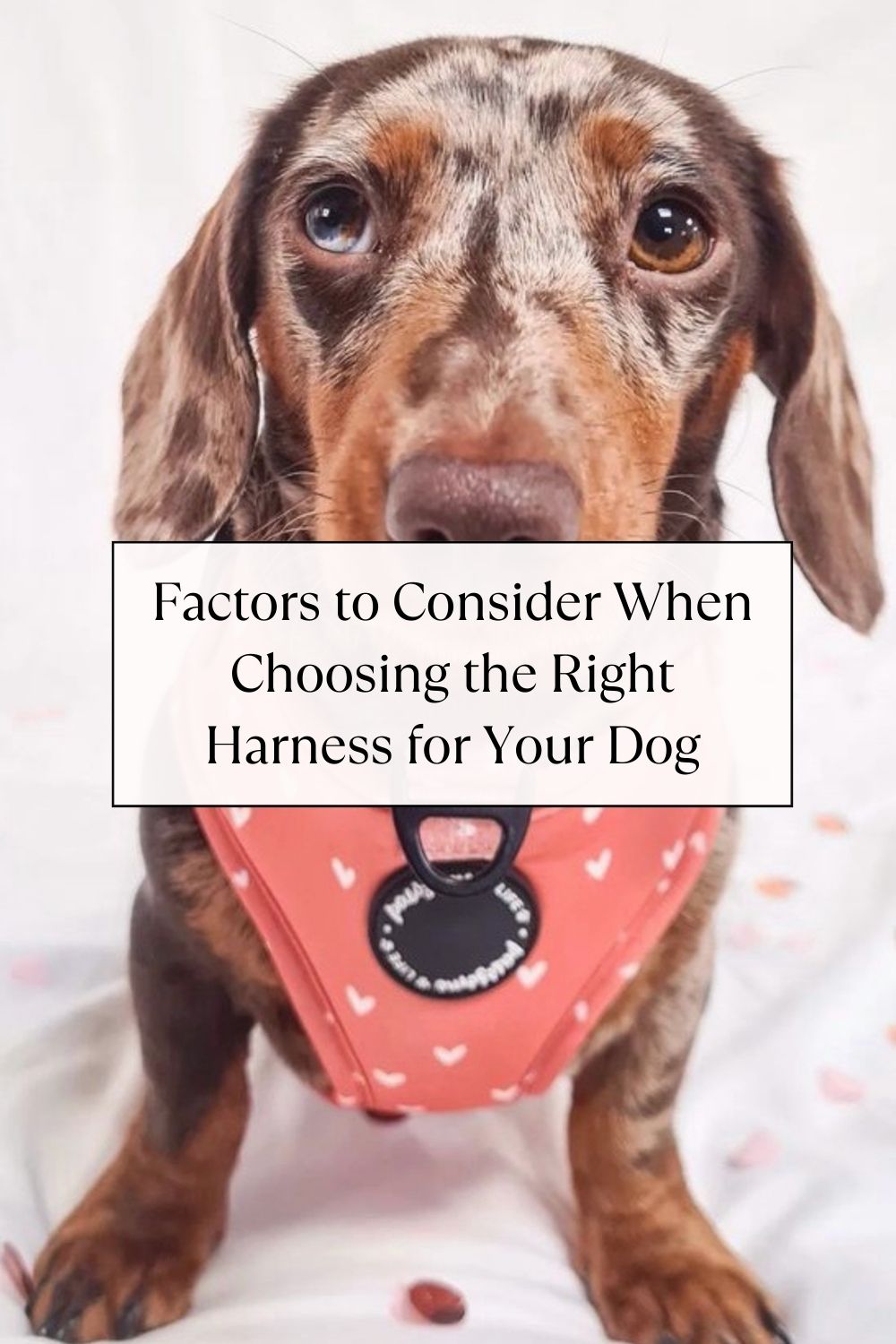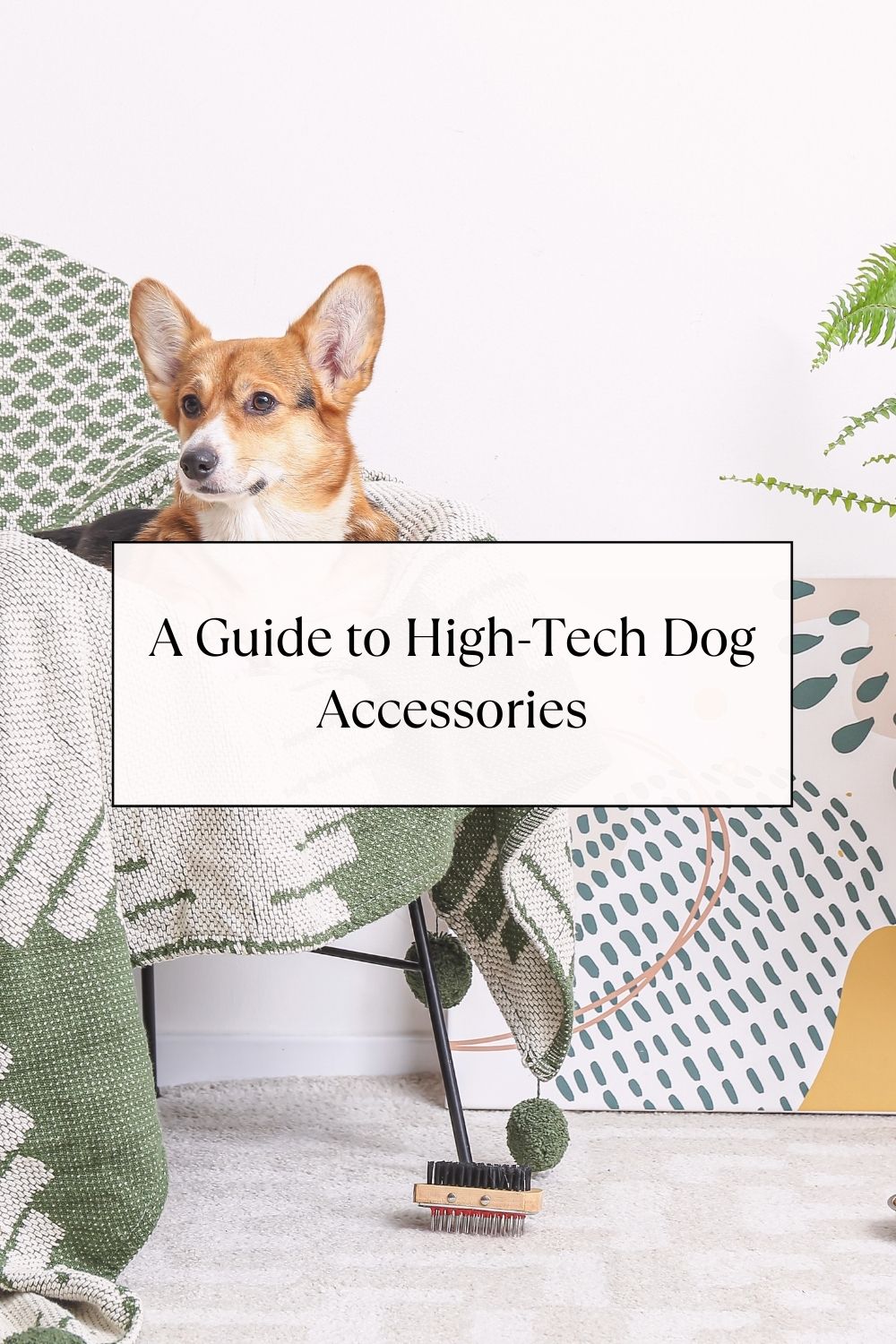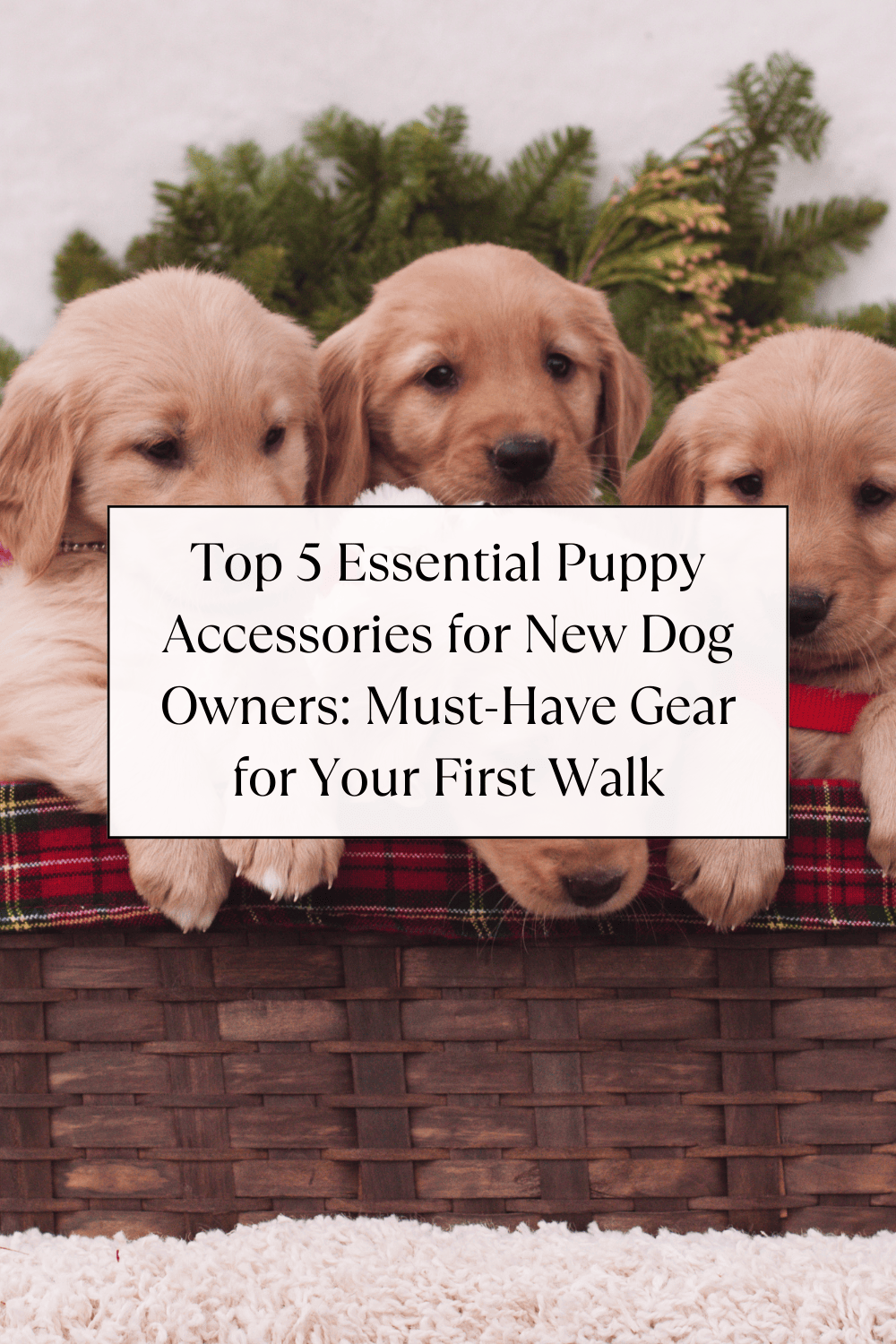
Factors to Consider When Choosing the Right Harness for Your Dog
Choosing the right harness for your dog is crucial for their comfort, safety, and overall well-being. With so many options available, it can be overwhelming to know which one is best suited for your furry friend. By considering several factors, you can ensure that you choose the perfect fit.
Why Choosing the Right Harness Is Important
When it comes to dog harnesses, the right choice is essential for multiple reasons. First and foremost, the harness should ensure both comfort and safety for your dog. It should not cause any discomfort or put too much pressure on their body. Additionally, a well-fitting harness prevents injuries and reduces the risk of your dog pulling or becoming tangled in the strap.
Ensuring Comfort and Safety
One of the primary factors to discuss when choosing the correct harness for your dog is ensuring their comfort and safety. A harness that fits properly and is made of high-quality materials will prevent any discomfort for your dog while allowing for easy movement. Look for harnesses that distribute pressure evenly across the body and have padding in key areas to avoid chafing or soreness.
Preventing Injuries and Discomfort
A poorly fitting harness can cause injuries to your dog's front legs or restrict their movement. Choosing the correct harness will prevent these issues, allowing your dog to walk, run, and play without any discomfort. Additionally, a properly fitting harness can prevent your dog from pulling, making walks more enjoyable for both you and your four-legged companion.
Understanding the Different Types of Dog Harnesses
When it comes to choosing the correct harness for your dog, it's essential to understand the different types available on the market. Each type of harness has its own unique features and benefits that cater to specific needs.
Back-clip Harnesses
Pros and cons
Back-clip harnesses, the little black dress of the dog harness world, are your classic, straightforward option. They feature a D-ring attachment on the back for your leash, which makes them easy to use and less likely to get tangled. However, they may not provide as much control for dogs who have a strong pulling instinct or haven't quite mastered their leash manners.
Best suited for: small or well-behaved dogs
If your dog is well-behaved on walks or is a small breed that doesn't have the strength to drag you down the street, a back-clip harness might be your perfect match.
Front-clip Harnesses
Pros and cons
These front clip harnesses sport a leash attachment point on the chest, which can help redirect a dog that pulls or lunges. This added control can be helpful for larger or stronger dogs. On the downside, front-clip harnesses can sometimes tangle more easily under a dog's front legs.
Best suited for: dogs that pull or need more control
If your dog has the tendency to channel their inner sled dog during walks, a front-clip harness might be the answer to your prayers.
Dual-clip Harnesses
Pros and cons
For those who love options, dual-clip harnesses offer the best of both worlds. These versatile harnesses have attachment points on both the back and chest, allowing you to switch between the two based on your dog's behavior or walking environment. The main drawback is that they can be bulkier and slightly more complicated to put on compared to their single-clip counterparts.
Best suited for: versatility and a range of situations
If you're the kind of person who packs for every possible scenario when going on vacation, a dual-clip harness is your canine equivalent. Great for dogs that occasionally pull or for those who like to switch up their walking routine.
Step-in Harnesses
Pros and cons
As the name suggests, step-in harnesses are designed for your dog to quite literally step into, making them a breeze to put on. They're often lightweight and less restrictive, which can be ideal for small or anxious dogs. However, they may not provide as much control or support for larger, stronger dogs.
Best suited for: small or anxious dogs
If your dog is more of a delicate flower than a brawny beast, a step-in harness might be the perfect fit for their gentle nature.
No-pull Harnesses
Pros and cons
No-pull harnesses are designed with the specific purpose of discouraging dogs from pulling on the leash. They often use a tightening mechanism or front-clip attachment to redirect your dog's attention and curb unwanted behaviors. While they can be effective for strong pullers or dogs in training, they might not be necessary for well-mannered pups.
Best suited for: strong pullers or dogs in training
If your dog has a PhD in pulling, a no-pull harness could be your secret weapon for a more enjoyable walking experience.
Support and Lift Harnesses
Pros and cons
Support and lift harnesses are specially designed to assist elderly, injured, or disabled dogs. They often feature built-in handles or support slings to help with mobility and alleviate pressure on joints. While they can be a lifesaver for dogs in need, they may not be necessary for healthy, able-bodied pups.
Best suited for: elderly, injured, or disabled dogs
If your dog is in their golden years or needs a helping paw with mobility, a support and lift harness can make all the difference in their quality of life.
Factors to Consider When Choosing a Dog Harness
Now that you are familiar with the different types of dog harnesses, it's crucial to consider several factors when making a decision. These factors will help you choose a harness that is not only the right fit but also meets your dog's specific needs.
The Size and Fit
One of the most important factors to consider is the size and fit of the harness. A well-fitting harness should allow you to fit two fingers between the harness and your dog's body. It should be snug enough to prevent your dog from slipping out, but not too tight that it causes discomfort or restricts their movement. Additionally, the harness should not rub or chafe your dog's skin, as this can cause irritation and discomfort. It's important to measure your dog's girth and neck size accurately before purchasing a harness to ensure the perfect fit.
Different harnesses have varying sizing charts, so it's essential to refer to the manufacturer's guidelines to find the right size for your dog. Some harnesses also come with adjustable straps, which allow you to customize the fit as your dog grows or gains/loses weight. When trying on a harness, make sure to check if it sits flat against your dog's body and doesn't ride up on their neck or restrict their shoulder movement. The straps should be positioned correctly to distribute the weight evenly and ensure maximum comfort for your dog.
It's important to regularly check the fit of your dog's harness as they grow or change in weight. A poorly fitting harness can lead to discomfort, chafing, and even injuries. So, make sure to check the fit periodically and make any necessary adjustments.
The Material and Durability
Common Materials Used in Dog Harnesses
Choosing the right harness for your dog isn't just about style or functionality—it's also about finding the perfect material that's comfortable, durable, and appropriate for your dog's needs. It's like picking the perfect outfit for a first date: you want to look good, feel comfortable, and make a lasting impression.
1. Nylon
Nylon is the multitasking superhero of dog harness materials. It's lightweight, strong, and weather-resistant, making it a popular choice for many dog owners. Plus, it comes in a kaleidoscope of colors and patterns to match your dog's unique style. However, keep in mind that some dogs with sensitive skin may find nylon irritating.
2. Polyester
Polyester harnesses are the comfy sweatpants of the dog world. They're soft, lightweight, and typically less expensive than other materials. While they may not be as strong or durable as nylon, they're a solid choice for dogs with low to moderate activity levels or those who prefer lounging over lunging.
3. Leather
For those who appreciate a touch of luxury, leather harnesses offer a classic, high-quality option. They're strong, durable, and often become more supple with age (just like a fine wine). However, they do require more care and maintenance, and they may be a bit pricier than their synthetic counterparts.
4. Mesh
Mesh harnesses are like the breathable workout gear of the dog harness world. They're lightweight, soft, and provide excellent airflow, making them ideal for hot weather or dogs that tend to overheat. Keep in mind, though, that mesh may not be as durable or supportive as other materials.
Considerations for Your Dog's Comfort
Now that you're a bonafide expert in dog harness materials, it's time to consider the elements that'll keep your pup feeling like they're walking on clouds.
1. Padding
Padding in a harness can make all the difference between a happy, comfortable dog and one that's itching to escape their walking gear. Look for harnesses with ample padding in areas that may be prone to rubbing or pressure, like the chest and under the front legs.
2. Adjustability
A harness that fits like a glove is key to your dog's comfort. Look for options with adjustable straps and buckles to ensure a snug, secure fit. After all, nobody likes wearing pants that are too tight or too loose, right?
3. Breathability
A breathable harness can keep your dog cool and comfortable during hot summer walks or intense squirrel-chasing sessions. Materials like mesh or lightweight fabric can help prevent your dog from overheating, while also reducing the risk of chafing or irritation.
The Ease of Use
The ease of use is another factor to think about when choosing a dog harness. Look for harnesses that are easy to put on and take off, especially if you have a dog that may become anxious or impatient during the process. Step-in harnesses or over-the-head harnesses are popular options that make it quick and easy to get your dog ready for a walk.
Tips for Choosing the Right Dog Harness
When it comes to choosing the correct harness for your dog, there are several factors to consider. By taking these factors into account, you can ensure that you select a harness that provides optimal comfort and safety for your furry friend.
Measure Your Dog Properly
Before purchasing a dog harness, it is crucial to measure your dog properly. This will ensure that you select the correct size and prevent any discomfort or potential harm to your pet.
Ready to play doggy tailor? Grab a flexible measuring tape and follow these steps to measure your dog for their new harness:
-
Measure the circumference of your dog's chest at its widest point, typically right behind their front legs.
-
Measure the circumference of your dog's neck, ensuring the tape is snug but not too tight.
-
Note your dog's weight, as some harnesses use weight as a sizing guideline.
With these measurements in hand, consult the sizing chart provided by the harness manufacturer to determine the best size for your pup.
Consider Your Dog's Behavior and Walking Style
Understanding your dog's behavior and walking style is another important aspect to consider when choosing a harness. If your dog tends to pull during walks, a no-pull harness that redirects the force to the side or back may be the best choice. Alternatively, if your dog is well-behaved and doesn't have any pulling issues, a standard harness that provides good control may suffice. By taking into account your dog's behavior and walking style, you can select a harness that suits their specific needs.
Seek Professional Advice
If you are unsure about which harness is best for your dog, don't hesitate to seek professional advice. A veterinarian or a professional dog trainer can provide valuable guidance and recommend the most suitable harness based on your dog's size, breed, and behavior. They can also provide tips on proper harness fitting and usage. Seeking professional advice can give you peace of mind knowing that you are making the right choice for your furry companion.
Conclusion
Choose the Right Harness for Your Dog's Comfort and Safety
When it comes to selecting a dog harness, it is crucial to choose one that prioritizes your dog's comfort and safety. By measuring your dog properly, considering their behavior and walking style, and seeking professional advice if needed, you can find the perfect fit. A well-fitting harness will prevent discomfort, injuries, and pulling, making walks enjoyable for both you and your dog. So take the time to choose the correct harness and ensure your furry friend's comfort and safety during your outdoor adventures together.
###
Q: What factors should I consider when choosing a harness for my dog?
A: When choosing a harness for your dog, it is important to consider the size of your dog, the purpose of the harness (e.g. walking, training, car rides), the fit and comfort of the harness, and the harness style that best suits your dog's needs.
Q: How do I choose the right size harness for my small dog?
A: When choosing a harness for a small dog, it is important to measure your dog's chest girth and neck size to ensure a proper fit. Most harnesses come in different sizes, so be sure to consult the manufacturer's size chart before making a decision.
Q: What is a no-pull harness and should I consider getting one?
A: A no-pull harness is designed to discourage your dog from pulling during walks. It typically has a front-clip design that helps redirect your dog's pulling force to the side, making it harder for them to pull forward. If your dog tends to pull, a no-pull harness can be a useful tool to help you regain control during walks.
Q: How can I ensure a harness fits my dog perfectly?
A: To ensure a perfect fit, measure your dog's chest girth and neck size accurately and compare it to the manufacturer's size chart. Additionally, look for adjustable harnesses that allow you to customize the fit to your dog's specific measurements. It is important to choose a harness that doesn't restrict your dog's movement or cause discomfort.
Q: What type of harness is best for a dog that doesn't pull?
A: If your dog doesn't pull, you have more flexibility in choosing a harness. An everyday harness that offers comfort and freedom of movement would be a good option. Look for features such as padding for added comfort and a design that allows your dog to walk naturally without any pulling or discomfort.
Q: How do I choose a harness that doesn't slip off my dog?
A: When choosing a harness, it is important to consider the design and adjustability. Look for a harness that has multiple points of adjustment to ensure a secure fit. Additionally, make sure the harness has a snug fit around your dog's chest and neck without being too tight. It's recommended to be able to fit two fingers comfortably between the harness and your dog's body.
Q: What are the benefits of using a front-clip harness?
A: A front-clip harness can help your dog have better control during walks. The front attachment point discourages pulling by redirecting your dog's forward motion to the side. This type of harness can also help improve your dog's walking manners and prevent pulling-related injuries. However, it is important to choose a front-clip harness that is comfortable and doesn't restrict your dog's movement.
Q: Can I use a harness for car rides?
A: Yes, you can use a harness for car rides. There are specially designed car harnesses available that help secure your dog in the car, preventing them from moving around or becoming a distraction to the driver. Look for car harnesses that are crash-tested and provide a secure attachment to your vehicle's seatbelt system.
Q: How should my dog wear the harness?
A: To ensure your dog wears the harness correctly, place it over your dog's head so that the front of the harness rests on their chest. Adjust the straps to achieve a snug but comfortable fit. Make sure the harness doesn't rub against your dog's skin or restrict their movement in any way. Always follow the manufacturer's instructions for proper harness usage.
Q: How can I stop my dog from pulling while wearing a harness?
A: While a harness can help in controlling pulling, it may not completely stop your dog from pulling. To address this behavior, consider incorporating dog training techniques to teach your dog leash manners and loose leash walking. Combining positive reinforcement and consistent training can help your dog learn to walk politely without pulling.
###





